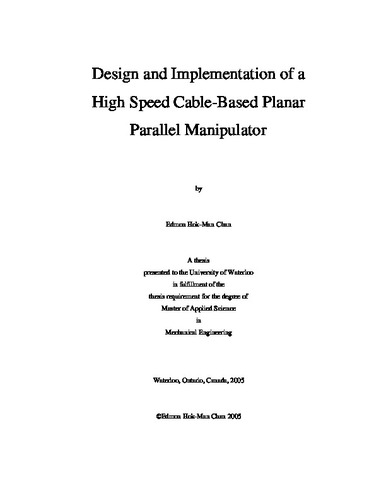UWSpace will be migrating to a new version of its software from July 29th to August 1st. UWSpace will be offline for all UW community members during this time.
Design and Implementation of a High Speed Cable-Based Planar Parallel Manipulator
| dc.contributor.author | Chan, Edmon | en |
| dc.date.accessioned | 2006-08-22 13:53:18 (GMT) | |
| dc.date.available | 2006-08-22 13:53:18 (GMT) | |
| dc.date.issued | 2005 | en |
| dc.date.submitted | 2005 | en |
| dc.identifier.uri | http://hdl.handle.net/10012/835 | |
| dc.description.abstract | Robotic automation has been the major driving force in modern industrial developments. High speed pick-and-place operations find their place in many manufacturing applications. The goal of this project is to develop a class of high speed robots that has a planar workspace. The presented robots are intended for pick-and-place applications that have a relatively large workspace. In order to achieve this goal, the robots must be both stiff and light. The design strategies adapted in this study were expanded from the research work by Prof Khajepour and Dr. Behzadipour. The fundamental principles are to utilize a parallel mechanism to enhance robot stiffness and cable construction to reduce moving inertia. A required condition for using cable construction is the ability to hold all cables under tension. This can only be achieved under certain conditions. The design phase of the study includes a static analysis on the robot manipulator that ensures certain mechanical components are always held under tension. This idea is extended to address dynamic situations where the manipulator velocity and acceleration are bounded. Two concept robot configurations, 2D-Deltabot, and 2D-Betabot are presented. Through a series of analyses from the robot inverse kinematic model, the dynamic properties of a robot can be computed in an effective manner. It was determined that the presented robots can achieve 4g acceleration and 4m/s maximum speed within their 700mm by 100mm workspace with a pair of 890W rotary actuators controlling two degrees of freedom. The 2D-Deltabot was chosen for prototype development. A kinematics calibration algorithm was developed to enhance the robot accuracy. Experimental test results had shown that the 2D-Deltabot was capable of running at 81 cycles per minute on a 730mm long pick-and-place path. Further experiments showed that the robot had a position accuracy of 0. 62mm and a position repeatability of 0. 15mm, despite a few manufacturing errors from the prototype fabrication. | en |
| dc.format | application/pdf | en |
| dc.format.extent | 1220750 bytes | |
| dc.format.mimetype | application/pdf | |
| dc.language.iso | en | en |
| dc.publisher | University of Waterloo | en |
| dc.rights | Copyright: 2005, Chan, Edmon. All rights reserved. | en |
| dc.subject | Mechanical Engineering | en |
| dc.subject | Cable-based robot | en |
| dc.subject | Parallel mechanism | en |
| dc.subject | high speed pick and place | en |
| dc.subject | design optimization | en |
| dc.subject | kinematics calibration | en |
| dc.title | Design and Implementation of a High Speed Cable-Based Planar Parallel Manipulator | en |
| dc.type | Master Thesis | en |
| dc.pending | false | en |
| uws-etd.degree.department | Mechanical Engineering | en |
| uws-etd.degree | Master of Applied Science | en |
| uws.typeOfResource | Text | en |
| uws.peerReviewStatus | Unreviewed | en |
| uws.scholarLevel | Graduate | en |

